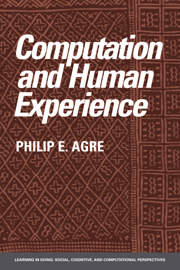Book contents
- Frontmatter
- Contents
- Preface
- 1 Introduction
- 2 Metaphor in practice
- 3 Machinery and dynamics
- 4 Abstraction and implementation
- 5 The digital abstraction
- 6 Dependency maintenance
- 7 Rule system
- 8 Planning and improvisation
- 9 Running arguments
- 10 Experiments with running arguments
- 11 Representation and indexicality
- 12 Deictic representation
- 13 Pengi
- 14 Conclusion
- Notes
- References
- Author index
- Subject index
5 - The digital abstraction
Published online by Cambridge University Press: 07 December 2009
- Frontmatter
- Contents
- Preface
- 1 Introduction
- 2 Metaphor in practice
- 3 Machinery and dynamics
- 4 Abstraction and implementation
- 5 The digital abstraction
- 6 Dependency maintenance
- 7 Rule system
- 8 Planning and improvisation
- 9 Running arguments
- 10 Experiments with running arguments
- 11 Representation and indexicality
- 12 Deictic representation
- 13 Pengi
- 14 Conclusion
- Notes
- References
- Author index
- Subject index
Summary
Digital logic
My goal in this chapter, as in much of this book, depends on who you are. If you have little technical background, my purpose is to help prepare you for the next few chapters by familiarizing you with the building blocks from which computers are made, together with the whole style of reasoning that goes with them. If you are comfortable with this technology and style of thinking, my goal is to help defamiliarize these things, as part of the general project of rethinking computer science in general and AI in particular (cf. Bolter 1984: 66–79).
Modern computers are made of digital logic circuits (Clements 1991). The technical term “logic” can refer either to the abstract set of logical formulas that specify a computer's function or to the physical circuitry that implements those formulas. In each case, logic is a matter of binary arithmetic. The numerical values of binary arithmetic, conventionally written with the numerals 1 and 0, are frequently glossed using the semantic notions of “true” and “false.” In practice, this terminology has a shifting set of entailments. Sometimes “true” and “false” refer to nothing more than the arithmetic of 1 and 0. Sometimes they are part of the designer's metaphorical use of intentional vocabulary in describing the workings of computers. And sometimes they are part of a substantive psychological theory whose origin is Boole's nineteenth-century account of human reasoning as the calculation of the truth values of logical propositions (Boole 1854).
- Type
- Chapter
- Information
- Computation and Human Experience , pp. 89 - 104Publisher: Cambridge University PressPrint publication year: 1997



